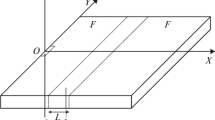Abstract
Processes of origination and propagation of crown fires are studied theoretically. The forest is treated as multiphase multicomponent porous reacting medium. The Reynolds equations for a turbulent flow are solved numerically taking chemical reactions into account. The method of control volume is used for obtaining the discrete analog. As a result of numerical computations, the distributions of velocity fields, temperature, oxygen concentration, volatile pyrolysis and combustion products, and volume fractions of the condensed phase at different instants are obtained. The model makes it possible to obtain dynamic contours of propagation of crown fires, which depend on the properties and states of forest canopy (reserves and type of combustible materials, moisture content, inhomogeneities in woodland, velocity and direction of wind, etc.).
Similar content being viewed by others
References
E. V. Konev, Physical Basis of Combustion of Vegetable Materials (Nauka, Novosibirsk, 1977).
C. E. Van Wagner, Can. J. Forest Res. 7, 23 (1977).
F. A. Albini, et al., Int. J. Wildland Fire 5, 81 (1995).
V. E. Alexander, “Crown fire thresholds in exotic pine plantations of Australasia,” PhD Thesis (Department of Forestry, Australian National Univ., 1998).
M. G. Cruz, et al., in Proceedings of the 4th International Conference on Forest Fire Research, Luso-Coimbra, Portugal, 2002.
R. C. Rothermel, in Proceedings of the 11th Internatonal Conference on Fire and Forest Meteorology, Missoula, USA, 1991.
J. H. Scott, et al., Rocky Mountain Forest and Range Experiment Station Res. Pap. RMRSRP-29 (USDA Forest Service, Fort Collins, 2001).
G. Xanthopoulos, “Development of a wildland crown fire initiation model,” PhD Thesis (Univ. Montana, 1990).
A. M. Grishin, Mathematical Modeling of Forest Fire and New Methods for Fighting Them (Nauka, Novosibirsk, 1992).
A. M. Grishin and V. A. Perminov, Combust., Explos. Shock Waves, No. 34, 378 (1998).
D. Morvan and J. L. Dupuy, Combust. Flame 127, 1981 (2001).
D. Morvan and J. L. Dupuy, Combust. Flame 138, 199 (2004).
S. V. Patankar, Numerical Heat Transfer and Fluid Flow (Hemisphere, New York, 1981).
V. A. Perminov, ”Mathematical modeling of crown and mass forest fires initiation with allowance for radiative-convective heat and mass transfer and two temperatures of medium,” Candidate’s Dissertation (Tomsk State Univ., Tomsk, 1995).
Author information
Authors and Affiliations
Corresponding author
Additional information
Original Russian Text © V.A. Perminov, 2015, published in Zhurnal Tekhnicheskoi Fiziki, 2015, Vol. 85, No. 2, pp. 24–30.
Rights and permissions
About this article
Cite this article
Perminov, V.A. Mathematical simulation of the origination and propagation of crown fires in averaged formulation. Tech. Phys. 60, 180–187 (2015). https://doi.org/10.1134/S1063784215020176
Received:
Published:
Issue Date:
DOI: https://doi.org/10.1134/S1063784215020176




